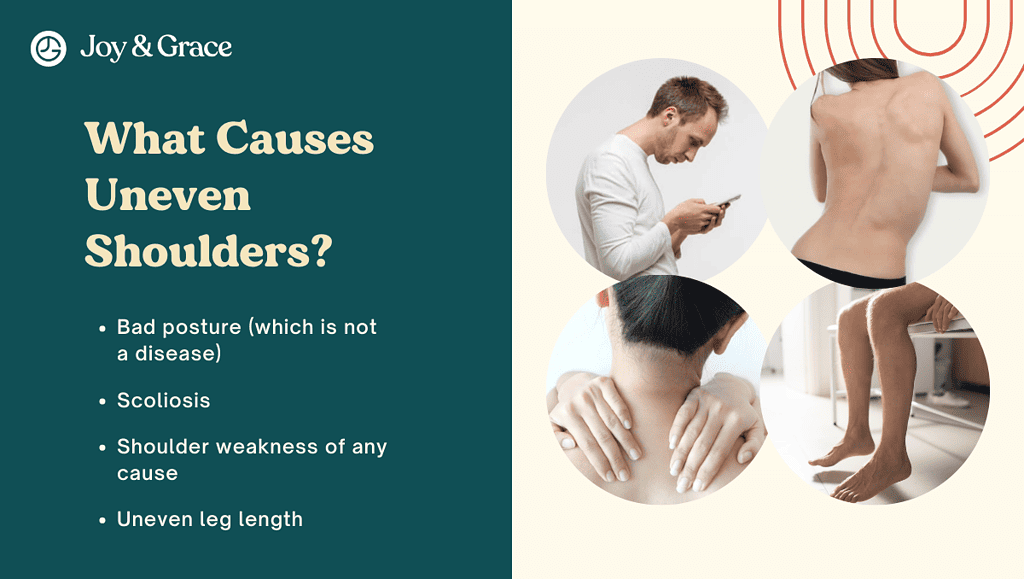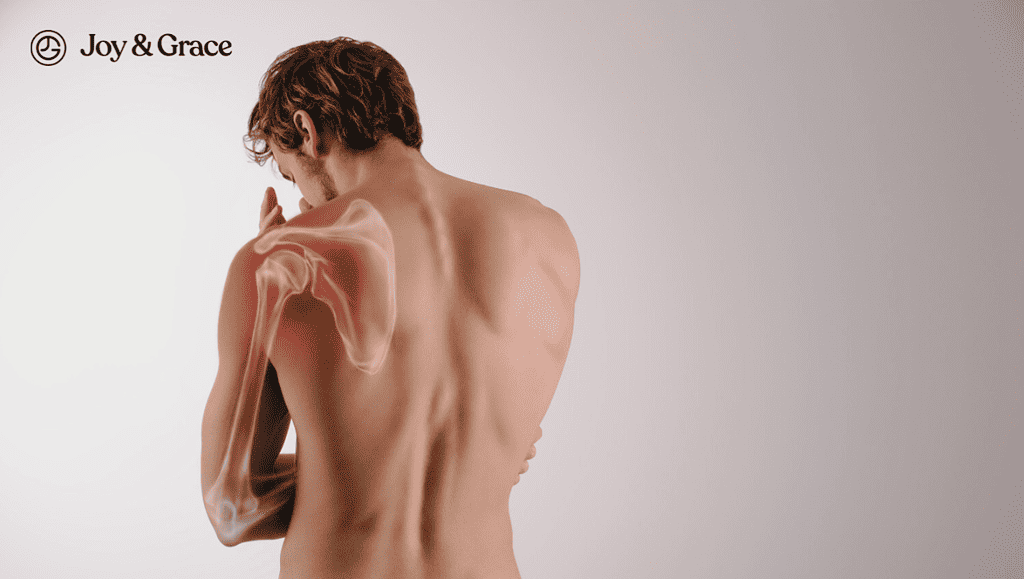It is a common misconception that having one shoulder higher than the other is the cause of neck pain. In reality, the two conditions are not necessarily related. While an elevated shoulder can be a symptom of an underlying condition, it is not the root cause of neck pain. In this article, we will explore the true causes of neck pain and dispel the myth that an elevated shoulder is the culprit. We will also discuss some simple exercises to help alleviate the pain and improve your posture.
Can Uneven Shoulders Cause Neck Pain?
Uneven shoulders are not known to cause neck pain. At least no studies exist showing an association between uneven shoulders and neck pain.
However, uneven shoulders are symptoms themselves of some conditions that do cause neck pain.
We'll discuss some of these conditions later, but one cause (which is not a disease) of uneven shoulders and neck pain is bad posture. You might simply be habitually flexing or elevating one of your shoulders while unaware of it.
Still, the cause of the neck pain is bad posture here. Uneven shoulders are not the cause.
In contrast, when it comes to uneven shoulders, studies suggest that:
If one of your shoulders is slightly higher than the other, that’s perfectly fine and probably not the cause of your neck pain.
That’s because very few people have perfectly symmetrical shoulder heights, per a study conducted in Turkey. The study showed that having one shoulder higher than the other is common and normal for most people.
The study was conducted by taking photographs and chest X-Rays of 91 adolescents who participated.
The results? Only 17 out of 91 adolescents had perfectly level shoulders, with an average height difference between shoulders of 0.3 inches (7.5 mm).
The study also said that uneven shoulder height shouldn't be thought of as abnormal right away. That's because it could lead to unnecessary treatment attempts.
All in all, there’s probably another cause for your neck pain, even if you notice you have one shoulder higher than the other.
What Causes Uneven Shoulders?

Some of the causes for uneven shoulders are:
- Bad posture (which is not a disease),
- Scoliosis,
- Shoulder weakness of any cause, and
- Uneven leg length
Bad Posture

Bad posture may be the most common cause of uneven shoulders.
In a study of 300 Chinese adolescents, researchers found that 100 had uneven shoulders with no other structural deformities. That means that 100 had uneven shoulders simply because of bad posture caused by various reasons.
Some of these reasons that are thought to cause uneven shoulder height by generating faulty postures include:
- Sedentary lifestyle
- Flat feet
- Osteoporosis
- Overuse or misuse of the shoulders
- Incorrect sleeping position or only sleeping on one side
- Using one side of the body to hold objects
But it's important to note that there aren't any solid studies that have directly linked these reasons to uneven shoulders.
Scoliosis

Scoliosis is an abnormal “sideways” curve of the spine.
Scoliosis causes uneven shoulders by “tilting” the spine (and upper body) to one side.
In a Swedish institution study, doctors found that patients with scoliosis were twice as likely to have neck problems than those without scoliosis.
Although it may affect anybody, from infants to adults, it most frequently begins in youngsters between the ages of 10 and 15.
Scoliosis can be improved by therapy, but it is often not a symptom of anything dangerous. If the scoliosis is mild, treatment is not necessarily needed.
Shoulder Weakness Of Any Cause
Shoulder Nerve Dysfunction
Long thoracic nerve paralysis is a rare disorder that can cause a condition called “scapular winging.”
Scapular winging happens when the muscles that keep the scapula in place lose their function. The long thoracic nerve makes these muscles function; hence, its paralysis also causes “scapular winging."
In this condition, one scapula sticks out, causing one shoulder to be higher than the other.
However, as we said earlier, this is a very rare condition. Most people who have uneven shoulders do not suffer from this condition.
Shoulder Injuries
Shoulder impingement syndrome is one of the injuries that can cause uneven shoulders.
After an injury, a painful shoulder has a limited range of motion and is used less. That could cause an imbalance in shoulder muscle strength, leading to uneven shoulder height.
Uneven Leg Length

An imbalance in leg length occurs when one leg is shorter than the other. The length difference might range from a few thousandths of an inch to many inches. Some kids have congenital differences that affect how quickly their legs grow.
Uneven leg length can cause one side of the body to be higher than the other. Obviously, this affects the shoulder as well.
What Are The Symptoms Of Uneven Shoulders?
Uneven shoulder height is not a disease; it is itself a symptom of another underlying cause. Thus, it doesn’t cause any symptoms. Symptoms are only indirectly associated with uneven shoulder height and vary based on the underlying cause.
Scoliosis Symptoms

As we discussed earlier, scoliosis is one of the most frequent causes of uneven shoulders. Typically, scoliosis is found before it has manifested any symptoms. A doctor or nurse usually finds it when a child gets a routine checkup.
Some of the scoliosis symptoms (besides uneven shoulder height) are:
- A shoulder blade, hip, or breast that is higher than the other
- A shoulder blade that sticks out farther than the other
- A skin fold on one side of the waist
- A “protruding” rib,
- Becoming shorter (due to the curved spine),
- Difficulty with sitting or standing,
- Trouble walking due to loss of coordination in legs,
- Hunch in the back, etc.
If the scoliosis is severe, it can start producing additional symptoms such as:
- Neck pain,
- Back pain, and
- Breathing difficulties - If the spine curves significantly, the lungs may not have enough space to function correctly. This could lead to breathing issues. Scoliosis of this severity typically begins in children under the age of 10.>>>
Shoulder Weakness Symptoms
1. Shoulder nerve dysfunction. Paralysis of any of the nerves powering the shoulder muscles causes various symptoms. Additionally, it can cause one shoulder to be higher than the other. Some of the additional symptoms of shoulder nerve dysfunction include:
- Neck pain
- Inability to lift, pull, and push heavy objects
- Inability to perform daily activities, such as brushing your hair and teeth or carrying grocery bags
- Shoulder blades severely sticking out.
2. Shoulder injuries. Symptoms of shoulder injuries vary greatly based on many factors. However, uneven shoulder height after an injury is usually caused by a more severe and untreated shoulder injury. That, in turn, causes muscle imbalance and uneven shoulder height.
Uneven Leg Length Symptoms
Uneven leg length is usually noticed in childhood, and the symptoms vary greatly from child to child. Symptoms also vary based on the extent of the length difference and the underlying cause of the condition.
Some typical signs of uneven leg length include:
- Neck, back, hip, knee, or ankle pain.
- One shoulder being higher than the other.
- Problems with balance or toe walking when walking.
- A knee that is flexed on the long side and hyperextended on the short side.
Should I Worry About Uneven Shoulders?
There’s nothing to worry about if you notice that you have one shoulder slightly higher than the other. Not having perfectly balanced shoulders is absolutely fine. Most people don’t have perfectly balanced shoulders, as we discussed at the beginning of the article.
Should I Go To The Doctor For Uneven Shoulders?
Our general guidance of when to consider medical checkups is if you have:
- Severely uneven shoulders. When one shoulder is significantly higher or lower than the other, you might want to visit a medical professional. Screening methods usually catch scoliosis in school. However, some people develop or find out about their scoliosis later on in life. The prognosis for scoliosis is excellent, and proper diagnosis is key.
- New-onset uneven shoulders after a shoulder injury. Shoulder injuries can take a toll on the muscles involved. If the muscles are not properly exercised after injury, they might become weak. That, in turn, could cause one shoulder to be higher or lower than the other. Additionally, this can also cause other symptoms, such as neck pain.
- Uneven shoulders combined with neck, hip, knee, and foot problems. These are uneven leg length symptoms. However, this condition is also usually noticeable in childhood. That means chances are you would’ve probably noticed it earlier if you had it. Still, a checkup wouldn’t cause any harm in this case.
Can Physical Therapists Fix Uneven Shoulders?
Physiatrists are the first people you should see if you are worried about having one shoulder higher than the other.
Physiatrists are medical doctors who are specialized in physical therapy and rehabilitation. Together with orthopedic surgeons, they’re the most qualified medical personnel for cases like this.
The biggest difference between physiatrists and physical therapists is that:
- Physiatrists are doctors
- Physical therapists are not
If your physiatrist recommends physical therapy, physical therapists carry out the exercises prescribed.
Physical therapists play a vital role in keeping you healthy. However, physiatrists are more qualified because of their longer education and training.
How Do You Fix Uneven Shoulder Height?
Uneven shoulder height can be fixed by treating the underlying cause. Although, if there’s no apparent cause of uneven shoulder height (i.e., you simply have bad posture), treatment is usually unnecessary.
If there is a structural deformity, however, you might need treatment.
Just as a quick reminder, three primary structural diseases cause uneven shoulder height:
- Scoliosis,
- Shoulder weakness of any cause, and
- Uneven leg length.
Another cause (which is not a medical condition) was bad posture.
Here’s a quick overview of these conditions and causes and their treatment options, starting with bad posture.
Fixing Uneven Shoulder Height Caused By Bad Posture
The best way to fix your posture is to strengthen your body and shoulders by exercising.
That can encourage symmetrical balance and alignment throughout your body and improve mobility.
Below you can find some exercises that we recommend doing at least three times per week.
It's best to complete them in a few quick bursts throughout the day. A resistance band and dumbbells are required for a few of the exercises.
Shoulder Raises
- Put your arms at your sides and keep your spine straight.
- Squeeze and slowly raise your shoulders toward your ears.
- After a short period of holding this posture, ease your shoulders back down.
- Repeat for 30 seconds.
Ear-To-Shoulder Stretches
- Sit or stand and keep your head and neck straight.
- Tilt your head toward your shoulder. Be careful not to move your shoulders.
- You can use your hand to hold or massage your opposite shoulder or gently pull your head down toward your shoulder.
- Hold this position for 30 seconds.
- Repeat at least twice on each side
Shoulder Blade Squeezes
- Stand up and bring your arms alongside your body.
- Contract your shoulder blades back.
- Hold like this for a few breaths.
- Slowly release to the starting position.
- Perform two to three sets of 10 repetitions.
Reverse Prayer Pose
- Join your hands behind your back with your fingertips pointing downward.
- Bring your shoulders back and open up your chest.
- Now, flip your hands over so that your fingertips are facing upward.
- Bring your palms together, and press into your hands while drawing your elbows back.
- Hold this position for 30 seconds.
- Repeat this stretch several times during the day.
Resistance Band Shoulder Squeezes
- Holding it in both hands, wrap a resistance band around something solid.
- Turn your hands so that your pinkies are down and your thumbs are up.
- Bring your hands back while squeezing both your shoulder blades. (You can do this with your arms at hip or shoulder level.)
- Do three sets of 12 repetitions.
Overhead Resistance Band Arm Stretches
- Stand with your feet hip-width apart.
- Holding onto the resistance band, extend both arms out in front of you, parallel to the floor.
- Next, raise your arms so they’re completely straight up.
- Stretch the band as wide as you can and try to form the shape of a "T" with your arms.
- Next, lower the band until it is behind your neck and hold it there for a few breaths.
- Repeat for three sets of 12 stretches.
Reverse Fly Exercises
- Sit on a bench's edge with your waist bending forward.
- Look down at the ground while holding a dumbbell in each hand.
- Extend your arms upward while contracting your shoulder blades.
- Maintain this position for some seconds. Make sure to keep your arms parallel to the ground.
- Go back to the starting position.
- Perform three 15-rep sets.
Overhead External Shoulder Rotations
- Hold a dumbbell with your right arm and lift until your elbow is at shoulder height and your hand is down.
- Rotate your shoulder to bring your arm up and your hand up toward the ceiling.
- Return to the starting position.
- On each side, perform three sets of 15 repetitions.
Fixing Uneven Shoulder Height Caused By Scoliosis
Everyone receives a unique course of treatment for scoliosis. However, if you or your child have mild scoliosis causing uneven shoulder height, treatment is usually not needed.
We've previously talked about how severe scoliosis can cause breathing issues. That, in addition to causing uneven shoulder height. Treatment is required for those with severe scoliosis.
Here’s a general summary of treatment options if uneven shoulder height is caused by scoliosis:
- No treatment is required if the spine or shoulders are not severely unbalanced. Most adults fall into this category.
- In children, if a child is still growing and the scoliosis is not too bad, the doctor might suggest waiting to see what happens. If the doctor or nurse notices scoliosis getting worse, the child may need to see a specialist.
- Bracing – This is also usually applicable only to children. A child might need a brace to help straighten the spine if:
- There’s still a lot of growing to do, and
- Scoliosis keeps getting worse in 6 months or less.
- Surgery -The doctors may advise surgery if the spine curves significantly. That applies to adults and children or adolescents who have finished growing up.
That’s because severe scoliosis typically gets worse over time.
Fixing Uneven Shoulder Height Caused By Shoulder Weakness
Shoulder nerve dysfunction - Is usually treated by a combination of physical therapy and range of motion exercises. Surgery is indicated in severe cases.
Shoulder injuries - Each shoulder injury has its own treatment protocol. Following the treatment plan is essential. In this way, you can prevent shoulder muscle imbalance, which could lead to uneven shoulder height.
Fixing Uneven Shoulder Height Caused By Uneven Leg Length
Uneven leg length treatments that don't involve surgery
Several non-surgical therapies may help improve function. That especially goes for cases with a slight difference in leg length (less than one inch). Some of them are:
- A shoe lift inside the shoe of the shorter leg to even out the differences in leg lengths. A shoe lift also makes walking and running easier and lessens back and neck pain.
- Physical therapy which includes special stretches and exercises.
- Custom prosthetics that are designed to fit on the shorter leg.
Uneven leg length treatments that involve surgery
These are usually reserved for more severe cases. Two techniques are mostly used:
- Leg shortening surgery. This method, also called "limb shortening," is a procedure in which a piece of bone from the thigh or lower leg is removed to make the leg shorter.
- Leg lengthening surgeries. This method, which is also called "limb lengthening," is a surgery in which a bone is broken and then slowly stretched apart over time.
What Is The Outlook For Uneven Shoulders?
The outlook for uneven shoulders is usually excellent.
Most of the time, people simply find them unpleasant and are unhappy with their appearance. They don’t report any neck or shoulder pain.
If that’s the case for you as well, we recommend doing some quick exercises, which we’ve summarized just above.
In cases with structural deformities, the outlook varies based on the extent of the disease. However, there are treatment options for just about every severity there as well.
Takeaway
So, to sum everything up
- No studies suggest that having one shoulder higher than the other causes neck pain.
- A slight difference in shoulder height is entirely normal.
- If you have severely uneven shoulders, chances are you’re suffering from a spine, shoulder, or leg deformity, which you might or might not be aware of.
- We recommend shoulder and back exercises to fix uneven shoulders caused by bad posture.















